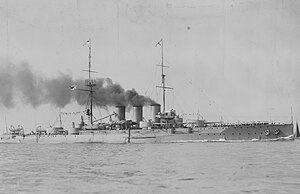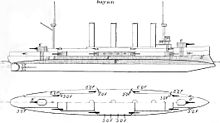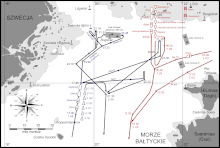
The Bayern class was a class of four dreadnought battleships built by the German Kaiserliche Marine. The class comprised Bayern, Baden, Sachsen, and Württemberg. Construction started on the ships shortly before World War I; Baden was laid down in 1913, Bayern and Sachsen followed in 1914, and Württemberg, the final ship, was laid down in 1915. Only Baden and Bayern were completed, due to shipbuilding priorities changing as the war dragged on. It was determined that U-boats were more valuable to the war effort, and so work on new battleships was slowed and ultimately stopped altogether. As a result, Bayern and Baden were the last German battleships completed by the Kaiserliche Marine.

SMS Bayern was the lead ship of the Bayern class of dreadnought battleships in the German Kaiserliche Marine. The vessel was launched in February 1915 and entered service in July 1916, too late to take part in the Battle of Jutland. Her main armament consisted of eight 38 cm (15 in) guns in four turrets, which was a significant improvement over the preceding König's ten 30.5 cm (12 inch) guns. The ship was to have formed the nucleus for a fourth battle squadron in the High Seas Fleet, along with three of her sister ships. Of the other ships only one—Baden—was completed; the other two were canceled later in the war when production requirements shifted to U-boat construction.

SMS König was the first of four König-class dreadnought battleships of the Imperial German Navy during World War I. König was named in honor of King William II of Württemberg. The battleship was armed with ten 30.5-centimeter (12 in) guns in five twin turrets and could steam at a top speed of 21 knots. Laid down in October 1911, the ship was launched on 1 March 1913. The construction of König was completed shortly after the outbreak of World War I; she was commissioned into the High Seas Fleet on 9 August 1914.

SMS Nassau was the first dreadnought battleship built for the Imperial German Navy, a response to the launching of the British battleship HMS Dreadnought. Nassau was laid down on 22 July 1907 at the Kaiserliche Werft in Wilhelmshaven, and launched less than a year later on 7 March 1908, approximately 25 months after Dreadnought. She was the lead ship of her class of four battleships, which included Posen, Rheinland, and Westfalen.

SMS Kronprinz was the last dreadnought battleship of the four-ship König class of the German Imperial Navy. The battleship was laid down in November 1911 and launched on 21 February 1914. She was formally commissioned into the Imperial Navy on 8 November 1914, just over 3 months after the start of World War I. The name Kronprinz refers to Crown Prince Wilhelm, and in June 1918, the ship was renamed Kronprinz Wilhelm in his honor. The battleship was armed with ten 30.5-centimeter (12 in) guns in five twin turrets and could steam at a top speed of 21 knots.

Slava was a pre-dreadnought battleship of the Imperial Russian Navy, the last of the five Borodino-class battleships. Completed too late to participate in the Battle of Tsushima during the Russo-Japanese War, she survived while all of her sister ships were either sunk during the battle or surrendered to the Imperial Japanese Navy.

The Bayan class was a group of four armored cruisers built for the Imperial Russian Navy around the beginning of the 20th century. Two of the ships were built in France, as Russian shipyards had no spare capacity. The lead ship, Bayan, was built several years earlier than the later three. The ship participated in several of the early naval battles of the Russo-Japanese War of 1904–05, and provided naval gunfire support for the Imperial Russian Army until she struck a mine. Bayan was trapped in harbor during the subsequent Siege of Port Arthur, and was sunk by Japanese artillery. She was salvaged and put into service with the Imperial Japanese Navy with the name of Aso. She mostly served as a training ship before she was converted into a minelayer in 1920. The ship was sunk as a target in 1932.

The Helgoland class was the second class of dreadnought battleships to be built for the German Kaiserliche Marine. Constructed from 1908 to 1912, the class comprised four ships: Helgoland, the lead ship; Oldenburg; Ostfriesland; and Thüringen. The design was a significant improvement over the previous Nassau-class ships; they had a larger main battery—30.5 cm (12 in) main guns instead of the 28 cm (11 in) weapons mounted on the earlier vessels—and an improved propulsion system. The Helgolands were easily distinguished from the preceding Nassaus by the three funnels that were closely arranged, compared to the two larger funnels of the previous class. The ships retained the hexagonal main battery layout of the Nassau class.
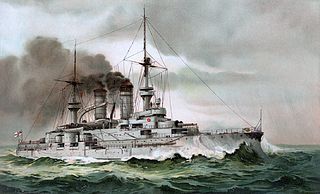
The Wittelsbach-class battleships were a group of five pre-dreadnought battleships built for the German Kaiserliche Marine in the early 1900s. They were the first battleships ordered under the Second Navy Law of 1898, part of Admiral Alfred von Tirpitz's fleet expansion program. The class comprised the lead ship, Wittelsbach, and Wettin, Zähringen, Schwaben, and Mecklenburg. All five ships were laid down between 1899 and 1900 and were finished by 1904. The ships of the Wittelsbach class were similar in appearance to their predecessors in the Kaiser Friedrich III class, but had a more extensive armor belt and a flush main deck, as opposed to the lower quarterdeck of the previous class. Both classes carried a battery of four 24 cm (9.4 in) guns in two twin-gun turrets.

The Roon class was a pair of armored cruisers built for the German Kaiserliche Marine in the 1900s. The two ships of the class, Roon and Yorck, closely resembled the earlier Prinz Adalbert-class cruisers upon which they were based. The Roon class incorporated slight incremental improvements, including a pair of extra boilers. The ships were easily distinguished from their predecessors by the addition of a fourth funnel. Though the additional boilers were meant to increase the ships' speed, both vessels failed to reach their designed top speed. In addition, the ships had comparatively light armament and thin armor protection, so they compared poorly with their foreign contemporaries, particularly the armored cruisers of their primary opponent, the British Royal Navy.

SMS Roon was the lead ship of her class of armored cruisers built for the German Kaiserliche Marine in the early 1900s as part of a major naval expansion program aimed at strengthening the fleet. The ship was named after Field Marshal Albrecht von Roon. She was built at the Kaiserliche Werft in Kiel, being laid down in August 1902, launched in June 1903, and commissioned in April 1906. The ship was armed with a main battery of four 21 cm (8.3 in) guns and had a top speed of 20.4 knots. Like many of the late armored cruisers, Roon was quickly rendered obsolescent by the advent of the battlecruiser; as a result, her career was limited.

SMS Prinz Adalbert was an armored cruiser built in the early 1900s for the Imperial German Navy. She was named after Prince Adalbert of Prussia, former Commander-in-Chief of the Prussian Navy, and was the lead ship of her class.

SMS Prinz Heinrich was a unique German armored cruiser built at the turn of the 20th century for the German Kaiserliche Marine, named after Kaiser Wilhelm II's younger brother Prince Heinrich. The second vessel of that type built in Germany, Prinz Heinrich was constructed at the Kaiserliche Werft in Kiel, being laid down in December 1898, launched in March 1900, and commissioned in March 1902. Prinz Heinrich's design was a modification of the previous armored cruiser, Fürst Bismarck, and traded a smaller main battery and thinner armor for higher speed. All subsequent German armored cruisers were incremental developments of Prinz Heinrich.

SMS Friedrich der Grosse was the second vessel of the Kaiser class of dreadnought battleships of the German Imperial Navy. Friedrich der Grosse's keel was laid on 26 January 1910 at the AG Vulcan dockyard in Hamburg, her hull was launched on 10 June 1911, and she was commissioned into the fleet on 15 October 1912. The ship was equipped with ten 30.5-centimeter (12 in) guns in five twin turrets, and had a top speed of 23.4 knots. Friedrich der Grosse was assigned to III Battle Squadron of the High Seas Fleet for the majority of World War I, and served as fleet flagship from her commissioning until 1917.

SMS Prinzregent Luitpold was the fifth and final vessel of the Kaiser class of dreadnought battleships of the Imperial German Navy. Prinzregent Luitpold's keel was laid in October 1910 at the Germaniawerft dockyard in Kiel. She was launched on 17 February 1912 and was commissioned into the navy on 19 August 1913. The ship was equipped with ten 30.5-centimeter (12 in) guns in five twin turrets, and had a top speed of 21.7 knots.

SMS König Albert was the fourth vessel of the Kaiser class of dreadnought battleships of the Imperial German Navy. König Albert's keel was laid on 17 July 1910 at the Schichau-Werke dockyard in Danzig. She was launched on 27 April 1912 and was commissioned into the fleet on 31 July 1913. The ship was equipped with ten 30.5-centimeter (12 in) guns in five twin turrets, and had a top speed of 22.1 knots. König Albert was assigned to III Battle Squadron and later IV Battle Squadron of the High Seas Fleet for the majority of her career, including World War I.

SMS Augsburg was a Kolberg-class light cruiser of the German Kaiserliche Marine during the First World War. She had three sister ships, SMS Kolberg, Mainz, and Cöln. The ship was built by the Kaiserliche Werft in Kiel; her hull was laid down in 1908 and she was launched in July 1909. Augsburg was commissioned into the High Seas Fleet in October 1910. She was armed with a main battery of twelve 10.5 cm SK L/45 guns and had a top speed of 25.5 knots.
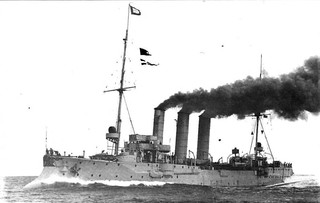
SMS Lübeck was the fourth of seven Bremen-class cruisers of the Imperial German Navy, named after the city of Lübeck. She was begun by AG Vulcan Stettin in Stettin in 1903, launched in March 1904 and commissioned in April 1905. Armed with a main battery of ten 10.5 cm (4.1 in) guns and two 45 cm (18 in) torpedo tubes, Lübeck was capable of a top speed of 22.5 knots.

Bayan was the third of the four Bayan-class armoured cruisers built for the Imperial Russian Navy in the early 1900s. The ship was assigned to the Baltic Fleet. She was modified to lay mines shortly after World War I began. Bayan laid mines herself and provided cover for other ships laying minefields. The ship fought several inconclusive battles with German ships during the war, including the Battle of Åland Islands in mid-1915. She also participated in the Battle of Moon Sound during the German invasion of the Estonian islands in late 1917, where she was damaged. Bayan was decommissioned in 1918 and sold for scrap in 1922.

Admiral Makarov was the second of the four Bayan-class armoured cruisers built for the Imperial Russian Navy during the mid-1900s. While initially assigned to the Baltic Fleet, the ship was detached to the Mediterranean several times before the start of World War I in 1914. She was modified to lay mines shortly after the war began. Admiral Makarov laid mines herself during the war and provided cover for other ships laying minefields. The ship fought several inconclusive battles with German ships during the war, including the Battle of Åland Islands in mid–1915. She also defended Moon Sound during the German invasion of the Estonian islands in late 1917. Admiral Makarov was decommissioned in 1918 and sold for scrap in 1922.
